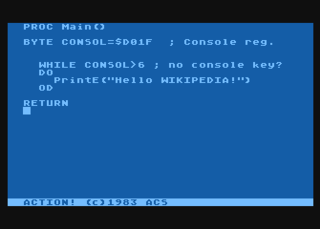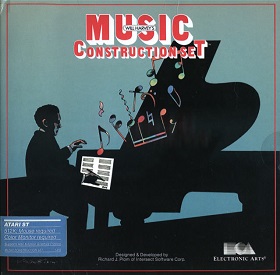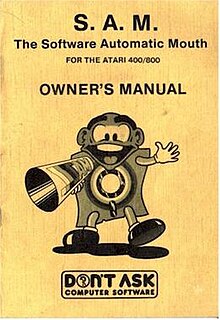 W
WMany pieces of software were available for the Atari 8-bit family of home computers. Software was sold both by Atari, Inc. and third parties. Atari also distributed software through the Atari Program Exchange from 1981 to 1984. After APX folded, many titles were picked up by Antic Software.
 W
WAction! is a procedural programming language and integrated development environment written by Clinton Parker for the Atari 8-bit family. The language, which is similar to ALGOL, compiled to high-performance code for the MOS Technologies 6502 of the Atari computers. Action! was distributed on ROM cartridge by Optimized Systems Software starting in 1983. It was one of the company's first bank-switched "Super Cartridges", with a total of 16 kB of code.
 W
WAtari BASIC is an interpreter for the BASIC programming language that shipped with the Atari 8-bit family of 6502-based home computers. Unlike most BASICs of the home computer era, Atari BASIC is not a derivative of Microsoft BASIC and differs in significant ways. It includes keywords for Atari-specific features and lacks support for string arrays, for example.
 W
WAtari DOS is the disk operating system used with the Atari 8-bit family of computers. Operating system extensions loaded into memory were required in order for an Atari computer to manage files stored on a disk drive. These extensions to the operating system added the disk handler and other file management features.
 W
WAtari Logo is ROM cartridge-based version of the Logo programming language for the Atari 8-bit family published by Atari, Inc. in 1983. It was developed by Logo Computer Systems, Inc. (LCSI) in Quebec, Canada. LCSI wrote Apple Logo, and the Atari version maintains strong compatibility with it.
 W
WAtariWriter is a word processor for the Atari 8-bit family of home computers published by Atari, Inc. as a 16KB cartridge in 1982. It replaced the Atari Word Processor, which shipped on a copy protected disk, required 48KB, and was incompatible with the XL computers.
 W
WContiki is an operating system for networked, memory-constrained systems with a focus on low-power wireless Internet of Things devices. Extant uses for Contiki include systems for street lighting, sound monitoring for smart cities, radiation monitoring, and alarms. It is open-source software released under the BSD-3-Clause license.
 W
WDOS XL is a discontinued Disk Operating System (DOS) written by Paul Laughton, Mark Rose, Bill Wilkinson, and Mike Peters and published by Optimized Systems Software (OSS) for the Atari 8-bit family of home computers. It was designed to be compatible with Atari DOS which came shipped with Atari, Inc.'s disk drives, which had also been written by the same team.
 W
WMini Office II, published by Database Software in 1986, was an office suite available for several home computers, among which were the Amstrad CPC, the Atari 8-bit family, the BBC Micro, the Commodore 64, and others. The software package could be purchased on cassette tape or floppy disk. Mini Office II was originally written for the BBC Micro Computer and was also available in EPROM format.
 W
WWill Harvey's Music Construction Set (MCS) is a music composition notation program designed by Will Harvey for the Apple II and published by Electronic Arts in 1983. Harvey wrote the original Apple II version in assembly language when he was 15 and in high school. MCS was conceived as a tool to add music to his previously published game, an abstract shooter called Lancaster for the Apple II.
 W
WPaperClip is a word processor for the Commodore 64, 128, and Atari 8-bit family published by Batteries Included in 1985. In the United Kingdom it was published by Ariolasoft.
 W
WSoftware Automatic Mouth, or S.A.M., is a speech synthesis program developed by Mark Barton and sold by Don’t Ask Software. The program was released for the Atari 8-bit family, Apple II, and Commodore 64. Released in 1982, it was one of the first commercial all-software voice-synthesis programs.
 W
WSpartaDOS X is a disk operating system for the Atari 8-bit family of computers that closely resembles MS-DOS. It was developed and sold by ICD, Inc. in 1987-1993, and many years later picked up by the third-party community SpartaDOS X Upgrade Project, which still maintains the software.
 W
WSpeedScript is a word processor originally printed as a type-in machine language listing in 1984-85 issues of Compute! and Compute!'s Gazette magazines. Approximately 5 KB in length, it provided many of the same features as commercial word processing packages of the 8-bit era, such as PaperClip and Bank Street Writer. Versions were published for the Apple II, Commodore 64 and 128, Atari 8-bit family, VIC-20, and MS-DOS.
 W
WTurbo-BASIC XL is an advanced version of the BASIC programming language for the Atari 8-bit family of home computers. It is a compatible superset of the Atari BASIC that shipped with the Atari 8-bit systems. Turbo-Basic XL was developed by Frank Ostrowski and published in the December 1985 issue of German computer magazine Happy Computer. A version for the 400/800 models was released shortly after as Frost Basic 1.4. Several modified versions working with different DOS systems have been released by other authors.
 W
WTypo Attack is an educational game for the Atari 8-bit family designed to improve the user's typing skill. It was written by David Buehler and published by the Atari Program Exchange in 1982. Buehler was seventeen when the game won the US$25,000 Atari Star Award for the best APX program of 1982. In 1984, Atari, Inc. moved Typo Attack into its official line as a cartridge.
 W
WVisiCalc is the first spreadsheet computer program for personal computers, originally released for Apple II by VisiCorp in 1979. It is often considered the application that turned the microcomputer from a hobby for computer enthusiasts into a serious business tool, prompting IBM to introduce the IBM PC two years later. VisiCalc is considered to be Apple II's killer app. It sold over 700,000 copies in six years, and as many as 1 million copies over its history.